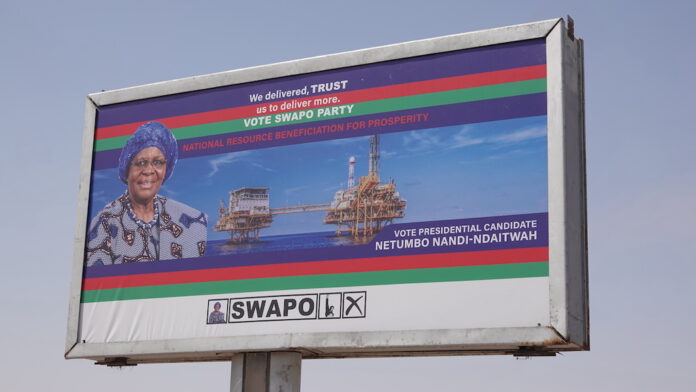Oxpeckers tracked 14 GH2 projects in Namibia, finding implementation has been slow and the only real growth has been in bureaucracy. John Grobler investigates.
The Namibian government’s commitment to a green hydrogen-fuelled economy appears to be wavering, judging by the ruling SWAPO Party’s 2024 election manifesto.
With just 400, mostly temporary new jobs to show for millions spent in promoting a fossil-free industrialisation process, the only real growth so far has been in the bureaucracy overseeing this sector of the economy.
While SWAPO’s election manifesto – released in September in advance of the national elections scheduled for November 27 – undertakes to “position Namibia as a key player in the production of green hydrogen and its derivatives”, GH2 has been relegated to a supporting act to 25-year-old plans to build a second hydro-power dam on the Kunene River and bring the off-shore Kudu gas resource into production for fuelling two new gas-fired power plants planned for Walvis Bay and Oranjemund.
Meanwhile, the bureaucracy around GH2 developments in the country has become increasingly complex and confusing. The Namibia Investment Promotions and Development Board (NIPDB) – the former Ministry of Industrialisation and Trade’s Investment Centre until it was relocated to the Office of the President in January 2021 – is to become a fully-fledged state-owned enterprise, NIPDB director Nangula Uaandja has announced.
At the same time, the green hydrogen initiative – now known officially as “NGH2P” – is to be incorporated into the Ministry of Mines and Energy as a programme in the Directorate of Energy programme, but reporting to an “implementing committee” comprising of the ministers of Finance and Public Enterprise; Environment, Forestry and Tourism; and the National Planning Commission (NPC).
“Additionally, the Green Hydrogen Council, chaired by the director-general of the NPC, provides strategic direction for the emerging green hydrogen sector. The NIPDB, on the other hand, is an entity that reports to the Office of the President, with its CEO reporting directly to the President, otherwise,” said NGH2P’s spokesperson Jona Mukesho in response to questions.
Effectively, this puts control of the GH2 programme in the hands of NPC director-general Obeth Kandjoze, who was replaced as Mines and Energy Minister in 2018 by Tom Alweendo after three years in that position.
Pilot-phase construction
Overall, implementation has been slow, with only three of 14 GH2 projects approved thus far having completed their pilot-phase construction.
Hyphen Hydrogen, which first acted as technical advisor to the late President Hage Geingob and then won an international competition to build a world-first pure clean energy hydrogen and nitrogen plant in the Tsau//Khaeb National Park, is currently running nearly a year behind schedule.
A worldwide shortage of electrolyser units needed to crack water into hydrogen and oxygen molecules remains a problem, with Cleanergy, Daures Green Village and HyIron all still awaiting delivery from the Chinese suppliers at the time of writing.
The rest of the 14 projects tracked by Oxpeckers, including Hyphen Hydrogen’s mega-project, are all in various stages of feasibility studies, environmental impact assessments and negotiating licensing agreements.
Only the HyIron green steel project 30km south of Namib mining town Arandis looks set to meet its end-2024 deadline of going into production – pending delivery of the all-important electrolyser units for its solar-powered rotary kiln that was installed last month.
Bigger projects like Hydrogen de France’s hydrogen- and battery energy storage plant that aims to boost Namibia’s limited local electricity output is in final stages of negotiations with Nampower. Construction would start end-2025, said HDF’s chief executive, Nicolas Lecomte.
Most GH2 projects are only in the conceptual phase, like Chekai Investments’ proposed Henties Bay green ammonia and modular oil refinery, with its own desalination plant that local councillor Peet Swart said is “… still just a concept of a plan, very short on any details”.
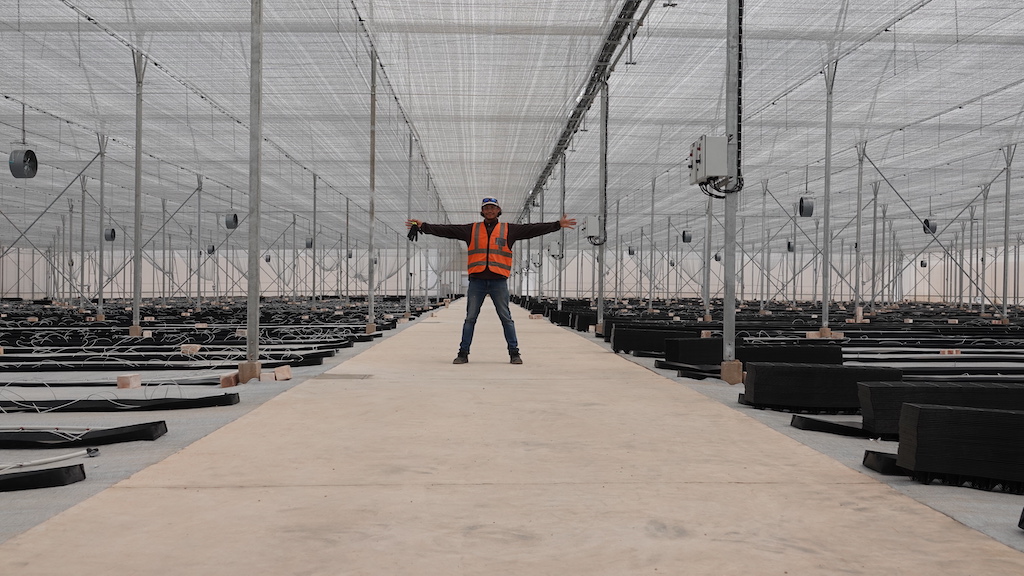
Scientific research station? Daures Green Village agri-engineer Fredddy Beukes inside the new 1,000m3 greenhouse where they plan to grow 100-250 tons of tomatoes, but face problems with alkaline water supplies and the lack of any packing warehouse or cold-store facility. Photo: John Grobler
Jobs
The data shows that so far the GH2 industry has created 400 mostly temporary jobs – a far cry from projections by the NIPDB and consulting firm McKinsey of 180,000 to 250,000 new jobs in five year’s time, and as many as 400,000 to 600,000 new jobs by 2050.
NGH2P’s spokesperson Mukesho said the projections had relied on several key assumptions and associated multiplier effects in respect of industry scale, import substitution, “employment/GDP intensity”, “bottom-up and econometric data” and “cross-validation” with similar industries in other, similarly-sized economies.
But economist Robin Sherbourne, speaking from London during the launch of the second Green Hydrogen Tracker report on October 4, said no matter how he applied the statistics, he could not achieve the same stellar results as those presented by the NGH2P.
“As a first mover in a new industry, one has to always ask if it is worth the risk and costs” because of the huge capital requirement for greenfield start-ups, Sherbourne cautioned. “It is always better to get it right from the start.”
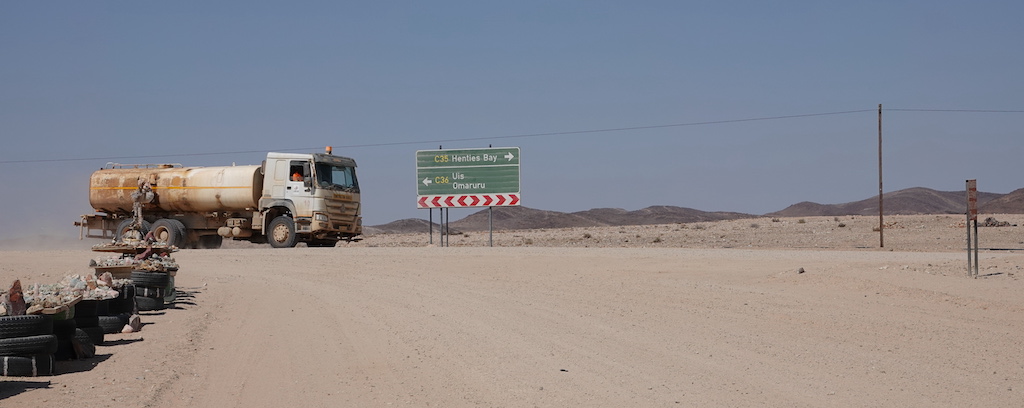
Running dry? A Chinese water truck carrying water supplies to the Xinfang Lithium Mine near the Daures Green Village site and which is also being supplied by a limited local aquifer that locals fear will soon run dry. Photo: John Grobler
Infrastructure
Economists and energy industry experts concur that, for GH2 to succeed in Namibia, billions more in public funding will have to be invested in both individual projects and critical infrastructure such as more desalination plants, new roads, railways and harbours, and extensive water and gas pipeline networks.
A lack of water remains the single-largest obstacle: although a second desalination plant, to be built next to the French nuclear utility Orana’s desalination plant at Wlotzkasbaken on the central coast, was approved a year ago, no tender for the project has been issued yet.
The experts also point to the costs involved. The 20 million m3 per annum Orana-owned Erongo desalination plant cost R1.6-billion to complete in 2010, with the 48-km-long pipeline to their Klein Trekkopje uranium mine near Arandis adding US$50-million to the pricetag. Today, the same infrastructure would cost R5.872-billion (about R4.653-billion for the desalination plant and R1.219-billion for the same pipeline infrastructure). With Cleanergy, HyIron, Eloff Hansson, HDF and Chiffon Energy all looking to Namwater for their water to be supplied via Arandis (30km away from the Trekkopje mine), the experts asked who would foot this bill.
Daures Green Village – at about 200km away from Wlotzkasbaken – is in an even more challenging situation: at an estimated US$1-million per kilometre for a suitably sized pipeline from the desalination plant, they would have instead to rely on a highly alkaline aquifer (pH9) that for the moment is still producing 90 cubic metres per day, said Daures agri-engineer Freddy Beukes.
Most of this is being stored after being put through a reverse osmosis plant, he said: 60,000 litres for human use, and 360,000 for watering the 100-ton-per-annum of tomatoes that Daures plans to produce from their state-of-the-art greenhouse and adjoining high-tech hothouse, both in final stages of completion. It remains to be seen if this highly alkaline water could be used in the still-to-arrive hydroliser unit that typically requires distilled water, Beukes acknowledged.
Although there were no signs of any packing warehouse or refrigeration facilities during a recent visit to Green Village, Beukes said they were in negotiations with a fruit and vegetable wholesaler to supply the Erongo region with up to 250 tons of tomatoes a year.
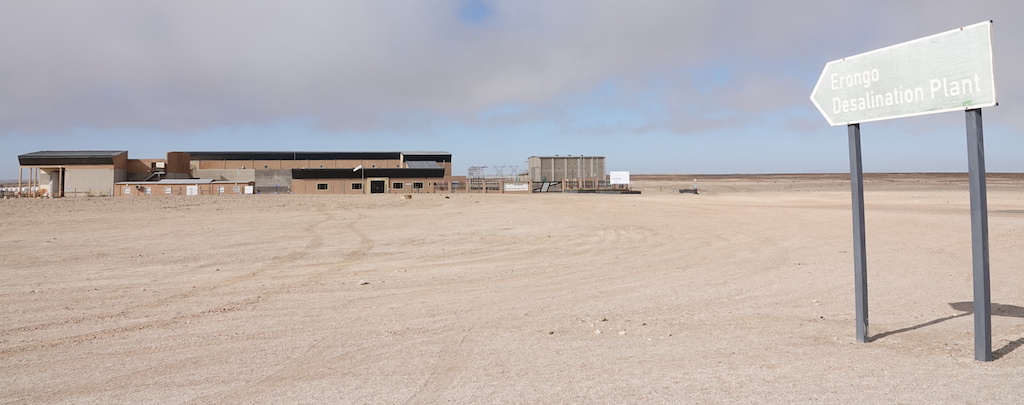
The Erongo Desalination Plant in Wlotzkasbaken, which supplies Orana’s uranium mine and which is to be upgraded to 25 million m3 of water per annum. A second such plant and pipeline today would cost in excess of R7-billion. Photo: John Grobler
Water supplies
Orana acknowledged that Cleanergy and Daures (among others) had approached them about water supplies, but re-affirmed Namwater’s legal monopoly over bulk water supply in Namibia. “[A]ll further negotiations for the supply of water will be conducted via… Namwater,” Orana’s Paris-based spokesperson responded by email.
The Erongo desalination plant is being upgraded to produce 25-million m3 of water per annum, which could be increased to 45-million m3 with additional investment if demand justified it, Orana said.
However, this might still not be enough, with Namwater data suggesting a 245Mm3/annum shortfall of potable water within the next five years, according to a recent Kondrad Adenhauer-commissioned study by Drs Detlof von Oertzen, Martin Schneider and Piet Heyns.
“In 2015, the total water demand in Namibia was about 427Mm3/a. However, this is estimated to increase to 770Mm3/a by 2030”, and only 525Mm3/a could at most be met,” they wrote.
With Namibia currently experiencing the worst drought since 1991, there seems little hope of this obstacle being resolved, Von Oertzen, a clean energy consultant, told Oxpeckers. “The green hydrogen economy may have over-sold itself somewhat and encouraged a whole lot of speculation for what appears to be more political than economic reasons,” he said.
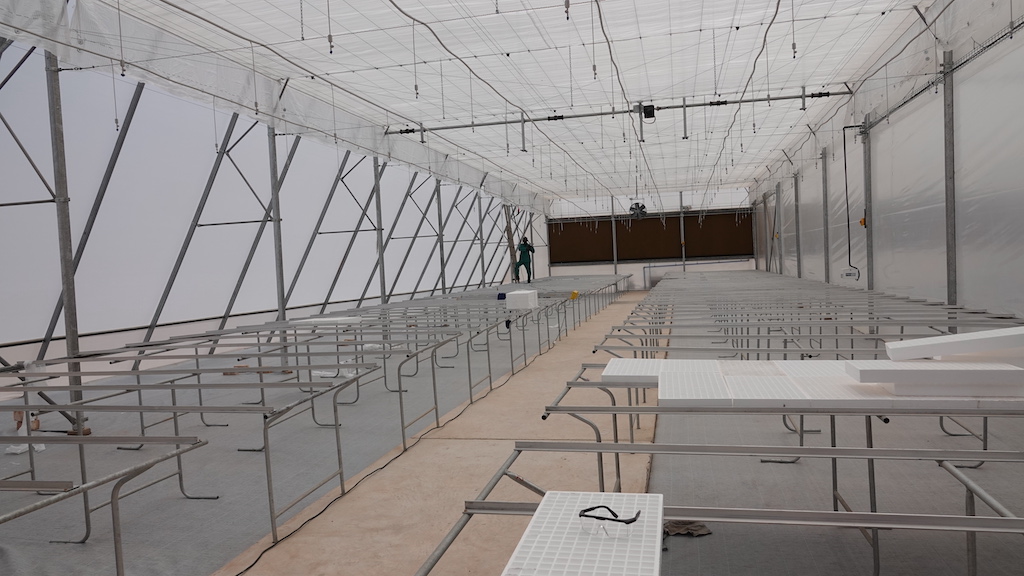
Disappointing employment figures: A worker putting the finishing touches to Daures’ new automated hothouse that will be run by five people. Photo: John Grobler
Green Village
At Daures there is little sign of the promised “green village” employing 3,000 people: only eight women are currently being trained to cultivate tomato plants, and the full staff complement in full operational mode would be 42 people.
Instead, Daures Green Village is pitching itself more as a pure scientific research station experimenting with clean energy in mass food production under arid conditions, according to Beukes.
All in all, local economic inclusion for local people has been very disappointing, said Eric Xaweb, chairperson of the Tsiseb Conservancy that together with the local traditional authority has given Daures’ holding company Enersense 15,000ha of communal land in return for a promised 10% share in equity.
As far as he could establish, none of the eight new Daures employees come from Uis, Xaweb said, even though many people from his home constituency had applied for the jobs. Information and benefits were being shared within small, privileged circles, he complained.
“We have not seen any real proof yet [of our shares]. Things have increasingly gone black and sour with each communication with management about this,” Xaweb said.
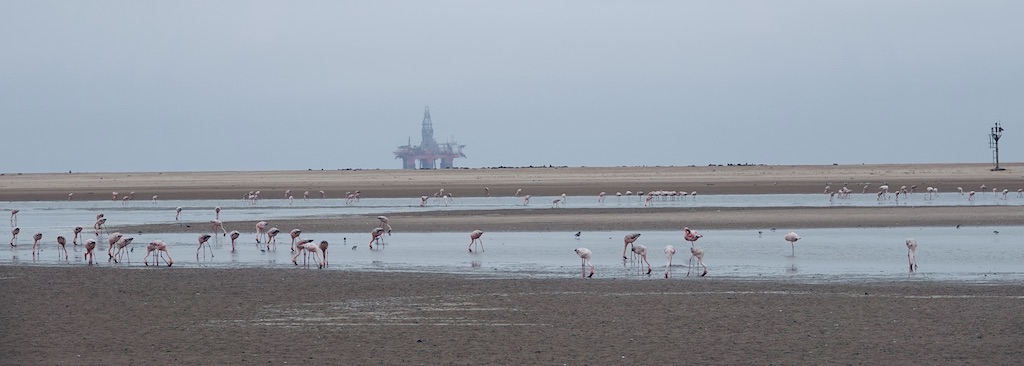
Quo vadis, green hydrogen? After initially pushing GH2 as their main economic development plan, SWAPO appears to be pinning its hopes on the Orange Basin oil resource going into production next year instead. Photo: John Grobler
Beneficiaries
An analysis of beneficiaries of the 14 GH2 projects tracked by oxpeckers.org suggests a degree of political syndication and advance speculation in the sector – some of it dating back to 2012-2014 in terms of company formation, corporate records showed.
Graham Hopwood, executive director of the Institute of Public Policy Research, pointed to the urgency of Namibia adopting the disclosure and governance methodologies supported by the Extractive Industries Transparency Index.
“There is no room for complacency in the green hydrogen sector,” he warned. “We are setting ourselves up for failure if we ignore the corruption risk.”
John Grobler is a Namibia-based associate at Oxpeckers Investigative Environmental Journalism. This investigation was supported by the Heinrich Böll Foundation, but does not reflect its views
- Data on the 14 GH2 projects is shared in the Oxpeckers Get the Data section here
- Find more investigations in our green hydrogen series here

Discover more from MAKANDAY
Subscribe to get the latest posts sent to your email.


